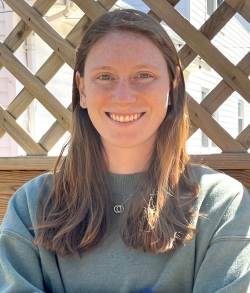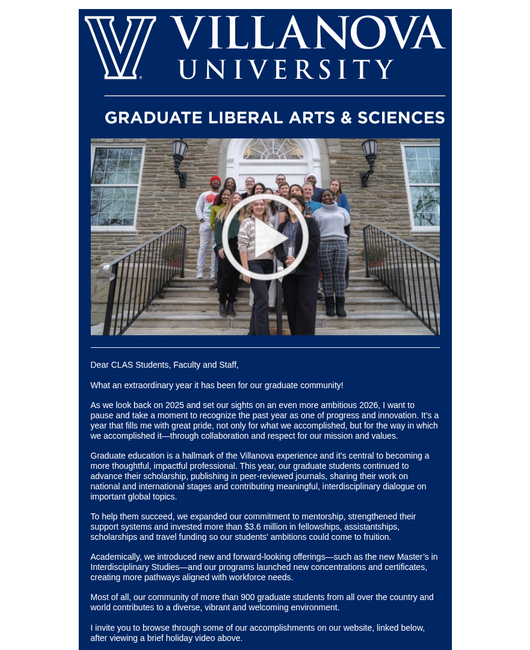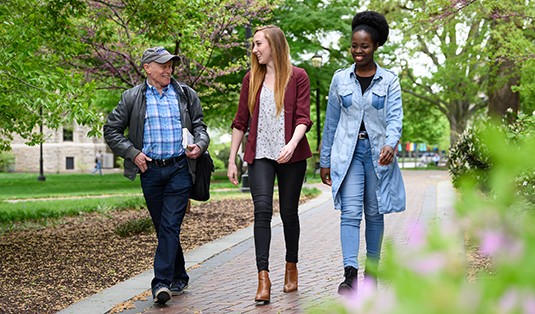Faculty Mentors, Collaborative Experiences Shape Master’s Student Path to Public History Career

Villanova History master’s student Jenna Cholowinski’s experience at Villanova has been shaped by faculty who have challenged her perspectives, provided relevant hands-on learning opportunities and shared insight into careers that fit with her skills and passion.
“Villanova History faculty are mentors who help guide you from the very beginning of the admissions process. They provide invaluable research experiences and expose you to many options for future career paths,” Cholowinski says.
Cholowinski cites Graduate Program Director Craig Bailey, PhD, for helping her navigate the graduate school application process, and her experience as a graduate assistant for Judith Giesberg, PhD, the Robert M. Birmingham Chair in the Humanities, her helping her learn what it is like to work in both academia and public history. Cholowinski worked with Dr. Giesberg and other graduate students on the Last Seen: Finding Family After Slavery project, which offers access to thousands of “Information Wanted” advertisements placed in newspapers by formerly enslaved people in the US looking for family members.
“The archival, research and technological skills I have gained from the ‘Last Seen’ project are invaluable and has developed my passion to work in an archive or library following graduation,” Cholowinski says. “In addition, I appreciated being able to build community with my peers working on this collaborative project.”
This past summer, Cholowinski further explored archival research in her internship at the Jackie Clarke Collection in Ballina, Ireland.
“This internship involved working with staff dedicated to educating their local community as well as submerging myself into a collection with over 100,000 pieces. It was a defining moment in my life,” she says. “I was able to talk to museum visitors, spend hours in its extensive archive, and even co-curate two exhibitions, which sharpened my writing, research and communication skills.”
Through her coursework and experiences, Cholowinski’s scholarly interests have evolved during her time at Villanova, with the support of Villanova faculty. While originally focused on Civil War and gender and women’s studies, she now studies disease and epidemics and, more broadly, public health. Cholowinski was able to develop her own concentration within the History master’s program.
“The MA program at Villanova is incredibly flexible and supportive of building a plan of study around my interests,” Cholowinski says. “I had the opportunity to write final papers about disease in contexts of different geographies and times. For example, I was able to write about how yellow fever epidemics influenced politics and economies in my Atlantic World course.”
Cholowinski credits her faculty advisor Julia Mansfield, PhD, who shares her interest in disease studies, with helping her to not only develop her concentration but also broaden her perspective and grow as a scholar.
“Her advice on final paper topics, establishing connections, and future career path planning has been second to none,” Cholowinski says. “More broadly, the history faculty are all driven to help mold students into people who challenge traditional perspectives and instead discuss a wide range of possibilities. The Villanova History program will get you out of your comfort zone and help you learn to challenge yourself.”
Learn more about Villanova's graduate program in History.
About Villanova University’s College of Liberal Arts and Sciences: Since its founding in 1842, Villanova University’s College of Liberal Arts and Sciences has been the heart of the Villanova learning experience, offering foundational courses for undergraduate students in every college of the University. Serving more than 4,500 undergraduate and graduate students, the College is committed to fortifying them with intellectual rigor, multidisciplinary knowledge, moral courage and a global perspective. The College has more than 40 academic departments and programs across the humanities, social sciences, and natural and physical sciences.


